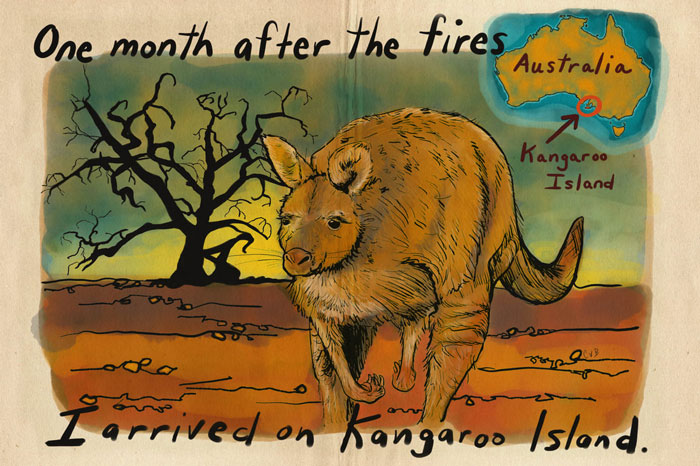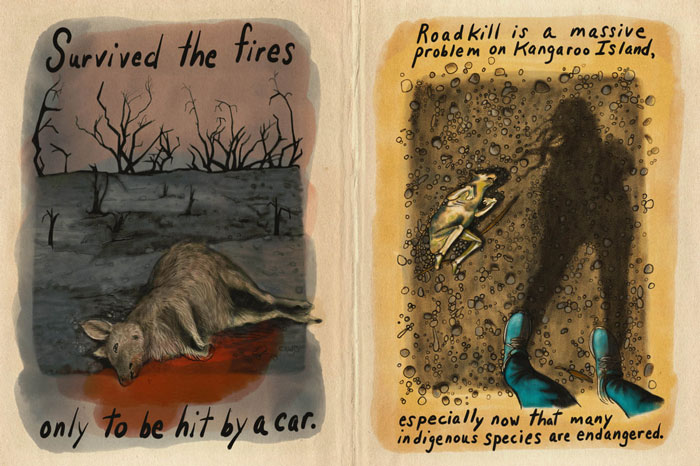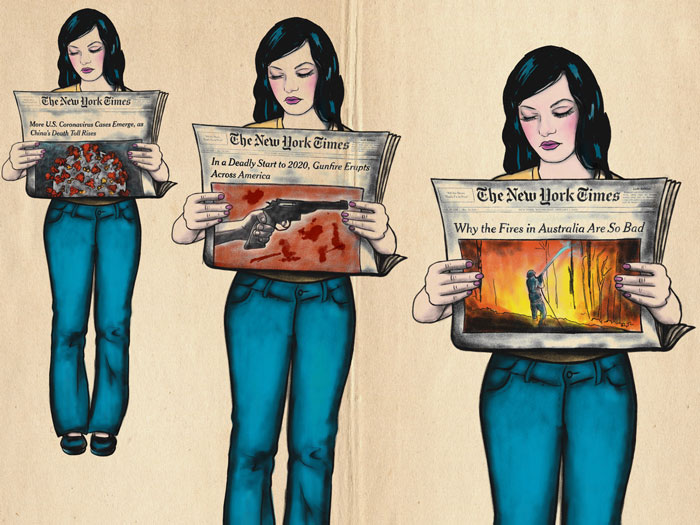
Artist Tells A Heart-Wrenching Story Of The ’19-20 Australian Bushfires In 12 Sad But True Sketches
The problem with consuming media is that news comes and goes and we often don’t hear how past stories were wrapped up or how the situation was resolved, if it was so to begin with.
The Australian bushfires were just a handful of months ago, and were soon pushed aside by the global coronavirus outbreak. However, that doesn’t mean that it’s magically over and that there are no implications whatsoever.
There were, and there still are. Cynthia von Buhler, is here to remind us of the tragedy that befell the South-Eastern part of the Australian continent just over half a year ago with her illustrations of the reality that the wildlife had to endure during the fires.
Artist Cynthia von Buhler documented in sketches the aftermath of the Australian bushfires earlier this year
Image credits: Cynthia von Buhler
Cynthia von Buhler is an award-winning American artist, author, and animal activist. Throughout her career, she has written and illustrated books for children and adults, created, produced, and directed theatrical productions, exhibited her art in galleries around the world, among many other things. She’s currently focusing on graphic novels, reportage illustrations, and animal rescue work.
Just a month after the bushfires in Australia, Cynthia traveled to Kangaroo Island—Australia’s third-largest island in South Australia, south-west of Adelaide—with the hopes of helping nature get back on its feet.
“One night in December, I was crying to my husband about all of the bad in the world. There were reports of more mass shootings, Covid-19 appeared in China, and Australia was on fire. He asked me what I would do if I could do anything to help. I said that I’d go to Australia and feed the starving koalas. He said, ‘go and do it!’ I hadn’t considered doing that before. I’ve never been to Australia and I don’t like traveling alone. I decided it was about time to do something rather than just cry about it,” said Cynthia von Buhler about the origins of the idea in an interview with Bored Panda.
“I was fully committed to doing this. Looking at a map of the island I located the hardest hit area and found a sanctuary right in the middle of it, the Hanson Bay Wildlife Sanctuary. I wrote to them explaining my background in art and wildlife care. I explained how documenting my work feeding the animals with drawings would be a way to help them bring awareness to the situation on Kangaroo Island in a novel way. I have worked for many top publications and I felt confident I could get the sketchbook out into the world.”
The sketches were done during her trip to Australia’s Kangaroo Island where she volunteered
Image credits: Cynthia von Buhler
Image credits: Cynthia von Buhler
Image credits: Cynthia von Buhler
Von Buhler volunteered at the Hanson Bay Wildlife Sanctuary for a month and also spent time with institutions like the Kangaroo Island Wildlife Park, the RSPCA, and the Australian Army. During this time, she was sketching her experiences and the reality that the Australian wildlife went through with the fires. The sketches tell the heart-wrenching story of the aftermath of the wildfires: a billion animals dead, while those who survived either still met a tragic fate as roadkill, or have been struggling to find food and water. Many younglings also lost their mothers, making things that much more challenging for them.
“When I first saw the miles of burned forest, I sobbed, but by the end of my month-long stay these burnt trees were growing new leaves. I learned from James Geddes, the co-owner of the sanctuary, that this I epicormic growth. Almost half the koalas, kangaroos and wallabies at Hanson Bay Wildlife Sanctuary had somehow survived the fires. I was surprised by the the resilience of nature and decided to incorporate that into my story,” said von Buhler.
She continued: “I also interviewed many people, like Vance Hayward, a volunteer with the RSPCA, about how and why the fires started. Meeting these people in person, spending time with Australians, and asking their opinions informed my drawings. Most Australians didn’t want to place all the blame on global warming. There were complaints about government choices and spending as well as the fact that these fires are a normal part of Australian life. I could make a whole sketchbook about global warming and how it’s hurting the planet, however, I wanted to focus on all aspects of the problem in Australia, and look for solutions that the average farmer could control themselves, such as controlled burning of dead brush.”
The illustrations tell the heart-wrenching story of a great disaster and nature’s signs of recovery
Image credits: Cynthia von Buhler
Image credits: Cynthia von Buhler
Image credits: Cynthia von Buhler
Due to the extraordinary circumstances, conservationists spent their days providing supplementary food for wildlife and feeding those orphaned in animal sanctuaries. Also, the army was dispatched to help out plantation owners rebuild, subsequently allowing them to put away some of their harvest to be used as supplementary wildlife feed.
“My main assignment was helping feed wildlife at Hanson Bay Wildlife Sanctuary, where the animals live free on their property. They don’t cage or feed the animals. This was an unusual situation though and we had to feed them until their habitat rejuvenated. All of the buildings at the sanctuary burned down except one beach cottage,” said von Buhler.
“Once there on the island, I met all of the organizations helping feed and care for the animals. I spent a day with the army when they were rebuilding fences, I visited the Kangaroo Island Wildlife Park where they were caring for orphaned babies and I spent a day helping feed kangaroos with the RSPCA. Those organizations received most of the press because people like seeing orphaned babies being fed, but Hanson Bay Wildlife Sanctuary isn’t a zoo and they don’t touch the wildlife. They are a conservation sanctuary dedicated to preserving the habitat for animals to live in the wild. This is why I was so excited to work with them.”
Apart from showing the tragedy that is the 2019-2020 Australian wildfires, the sketches serve an educational purpose as well, explaining how koalas are fed using PVC vases, how orphaned koalas are known as Joeys, how lightning causes fires and how nature has actually adapted to avoiding them (exemplifying kangaroos, echidnas, and goannas).
These also serve an educational purpose, explaining the situation, how it’s being solved and other nuances
Image credits: Cynthia von Buhler
Image credits: Cynthia von Buhler
Image credits: Cynthia von Buhler
However, such work is anything but easy, as explained von Buhler: “I run a small, private animal sanctuary an hour outside of New York City called The Fur Gnarl. Seventy-five pigeons, two mini pigs, eight chickens, two roosters, one rabbit, one dog and four cats who were rescued by me live there, as well as all the wild animals on our eight acres. Many people think that running a sanctuary is relaxing and easy. You get to spend time in nature with beautiful creatures.”
She continued: “What they don’t realize is that you see a lot of death when you are helping animals in need. The most challenging part of documenting wildlife is showing the death we experience when trying to help them. Most people only want to see happy pictures, but my job as a reportage illustrator is to give an accurate description of what I encounter. Some of that is the thrill of helping animals survive and some is death. Drawing the mass grave of animals was the hardest part. It was not easy to experience that. Drawing it allowed me to add beauty and majesty to the grave site whereas a photo would have been too graphic.”
The good news is that nature is recovering. One of the sketches mentions that burnt trees were sprouting epicormic growths allowing for photosynthesis at the time of her visit. In the long run, they are expected to recover and become a home to much of Australia’s wildlife once again. Some images from this series were selected by American Illustration as the best illustrations of the year and are planned to appear in their annual hardcover book. The story was also featured in the Washington Post.
Some of the images in this series were selected by American Illustration as the best illustrations of the year
Image credits: Cynthia von Buhler
Image credits: Cynthia von Buhler
You can also watch a narrated video retelling the story of the sketches
Video credits: Kangaroo Island Sketchbook by Cynthia von Buhler
The 2019-2020 bushfire season in Australia was one of the harshest in decades, affecting over 46 million acres of land with over a billion animals dead and 3,500 homes lost. 34 people have also died in the wildfires.
This isn’t the end as Cynthia is planning more sketchbooks that would cover other natural disasters that have affected the wildlife: “Iplan do many more of these once Covid-19 passes and I can start traveling again. I hope to travel to Thailand and Africa next. More people need to understand the plight of elephants who are forced to give rides in Thailand. I visited Elephant Nature Park, a beautiful sanctuary in Chiang Mai, where tourists can pay to bring an elderly elephant to a river and bathe him. That experience was far more satisfying that riding a poor elephant at the tourist trap next door.”
She also explained her fascination with Akashinga, an elite group of women who protect wildlife from poachers in Africa, who she’d love to draw, and she also has a dream to one day travel to Antarctica to document how global warming is affecting wildlife there. So, consider following Cynthia on her Instagram, Twitter and Facebook to be the first to know when these sketchbooks come out, and you can also check out her website for more info.
Also, consider helping the wildlife on Kangaroo Island by donating, whether funds or your time if you live in the area, to the Hanson Bay Wildlife Sanctuary, the Kangaroo Island Wildlife Park, or the RSPCA Royal Society for the Prevention of Cruelty to Animals.
What are your thoughts on this? Let us know in the comment section below!
The artist also shared some sketches that weren’t a part of the story, but were tied to the tragic disaster
Image credits: Cynthia von Buhler
Image credits: Cynthia von Buhler
Image credits: Cynthia von Buhler
Image credits: Cynthia von Buhler
12Kviews
Share on FacebookBreaks my heart to hear that they're still struggling to recover. I'll send more money.
Breaks my heart to hear that they're still struggling to recover. I'll send more money.

 Dark Mode
Dark Mode 

 No fees, cancel anytime
No fees, cancel anytime 

































































114
16